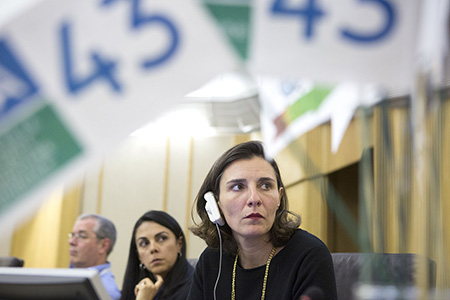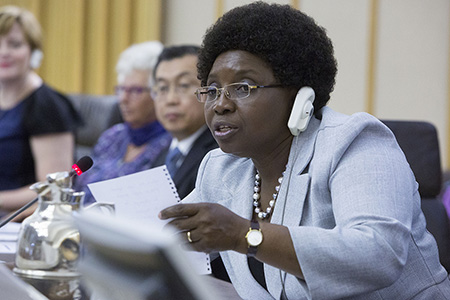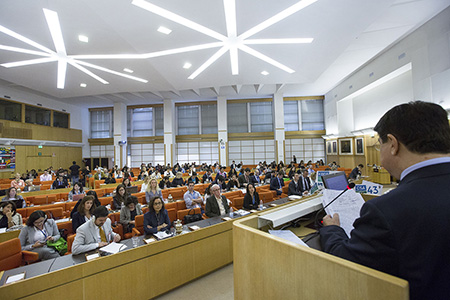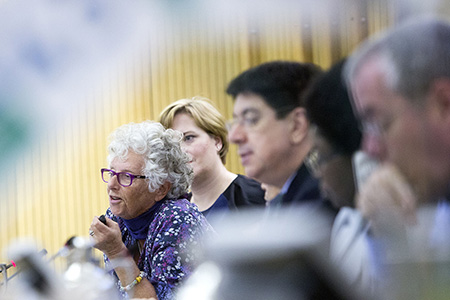Summary
The following side events were covered by ENBOTS on Tuesday, 18 October 2016:
- How to Reduce Food Loss and Waste While Connecting Smallholders to Markets
- The Role of Livestock in Sustainable Agriculture: Delivering for People, Animals and Planet
IISD Reporting Services, through its ENB+ Meeting Coverage, has provided web coverage of CFS 43 and selected side-events. The summary report of CFS 43 is available in HTML and PDF.
How to Reduce Food Loss and Waste While Connecting Smallholders to Markets
Organized by Brazil, Italy, Costa Rica, FAO
This side event, moderated by Anna Lartey, Nutrition and Food Systems Division, FAO, welcomed solutions to help smallholders reduce food losses, connect to markets, protect their livelihoods and increase their incomes.
Maria Laura da Rocha, Permanent Representative of Brazil to FAO, stressed the importance of reducing food loss and waste within the context of SDG 12.3 – to halve by 2030 per capita global food waste at the retail and consumer levels and reduce food losses along production and supply chains, including post-harvest losses. She added that ensuring smallholders have access to markets is critical to achieving the SDG.
Laura Brenes, National Network for Food Loss and Waste Reduction, Costa Rica, noted that the manipulation or handling of produce is one of the biggest contributors to food loss facing independent farmers in her country, adding that farmers’ associations can contribute to waste reduction in this regard. Such associations, she said, could help connect farmers to a client that will demand more value added and help meet quality standards.
Aurora Cavallo, Universitas Mercatorum, Italy, said Italy loses up to 1 million tonnes of agricultural products each year. She underlined several ways for smallholders to reduce such loss, including the need to improve: supply chain management; access to low-cost handling and storage technologies; packaging to keep food fresh; and market access. She also listed several cross-cutting governmental strategies: set food loss and waste reduction targets; create entities devoted to reducing food waste; increase financing and regulatory intervention; and increase capacity building, especially for smallholders.
Xie Jianmin, Deputy Permanent Representative of China to FAO, reported on his country’s efforts to reduce food waste, which has seen the number of hungry people drop by 100 million. Measures taken to reduce waste and better protect smallholder farmers include, inter alia, promoting legislative processes and regulations, investing in storage facilities, accelerating food logistics and distribution, and promoting new technologies. He added that better communication is needed to provide smallholders with timely market information and technologies.
Caoi Tiberio Dornelles da Roca, Ministry of Social and Agrarian Development of Brazil, reported on the success of food banks throughout the country, which function as points of storage and distribution. He also highlighted the government’s Food Purchase programme, which buys agricultural products from smallholders and delivers them to at-risk categories, including children and youth through school feeding programmes.
Judith Hitchmann, Urgenci, extolled the benefits of community-supported agriculture (CSA), noting it is one of the best examples of a successful, alternative food distribution system that provides affordable healthy food for consumers. CSA, she said, includes little or no food loss on the farm, with little or no miles of packaging. Citing a UK study, she said supermarket value chains have a much higher rate of food loss and waste than CSA.
Ann Steensland, Global Harvest Initiative, noted that many private sector actors are working to reduce waste and connect smallholder farmers to larger markets. This, she said, includes national and multinational companies investing in bio-fortified seeds and orphan crops, offering weather index insurance and providing affordable storage technologies. She said infrastructure, such as roads, electricity and communications, is important and also access to affordable financing.
Aurora Cavallo, Universitas Mercatorum
Copyright ©FAO. ©FAO/Pier Paolo Cito
Anna Lartey, Nutrition and Food Systems Division, FAO
Copyright ©FAO. ©FAO/Pier Paolo Cito
Copyright ©FAO. ©FAO/Pier Paolo Cito
Judith Hitchmann, Urgenci
Copyright ©FAO. ©FAO/Pier Paolo Cito
The Role of Livestock in Sustainable Agriculture: Delivering for People, Animals and Planet
Organized by Senegal, Kenya, FAO, University of Winchester Centre for Animal Welfare, The Brooke
This side event, chaired by Badi Besbes, Animal Production and Health Division, FAO, explored how livestock can best support food security, nutrition and livelihoods, including their role in food production value chains. Besbes said that livestock provide essential services, including a third of human protein intake, and have an important cultural role in society, especially in rural communities.
Ali Mohamed dit Séga Camara, National Council for Food Security, Senegal, highlighted the crucial role equine play in the livelihoods of national economies; in Senegal 28.2% of households are livestock keepers. He noted that horses, donkeys and mules are used to plow fields and for the transportation of fuel, water and agricultural products, adding that most households in the West African country, and their income, come directly from these animals. The poorest households, he said, are those who do not have a working animal.
Kiss Juma Ngeiywa, Ministry of Agriculture, Livestock and Fisheries, Kenya, said livestock are an integral part of food security in rural communities in Africa. Families with livestock, he said, have better overall nutrition, and are often viewed on par with conventional currency, serving as a family’s savings or fixed deposit. To protect this valuable resource, Ngeiywa said that it is important for people to look after the welfare of animals as they are an essential part of one’s livelihood.
Philip Lymbery, University of Winchester Centre for Animal Welfare, decried the development of large-scale, industrial agriculture, which he viewed as one of the biggest threats to global food security. He noted that the largest area of food production waste is feeding crops edible to humans to industrialized-reared animals. To achieve humane and sustainable food production, Lymbery stressed the need to return to more sustainable farming practices, such as mixed-rotational or free-range farms, or pastoralism, where animals are treated more humanely.
Dil Peeling, The Brooke, said working livestock play a fundamental role in agricultural and animal-sourced food production, with hundreds of millions of people depending on them for income and food security. He noted that they represent an important asset of the poor and help keep those that benefit from their labor out of poverty. Peeling added that despite their indispensable contributions, working livestock remain largely invisible in the eyes of decision-makers and have not been recognized in development policies. This, he said, needs to change, especially as livestock offer a huge potential in delivering food security.
Fabio Fuseli, Ministry of Agriculture of Italy, noted that recognition of livestock in policies is being reflected in national agenda policies, as well as in EU legislation and legislative measures to manage sustainability.
In discussions, participants considered, inter alia, the low level of investments in livelihood development compared to agriculture, lack of understanding of livestock issues, particularly in the West, animal hygiene and health, and the impact of livestock on climate change.
Contacts:
- Jennifer Dias, The Brooke (UN Advocacy Manager) – Jennifer.dias@thebrooke.org
More Information:



